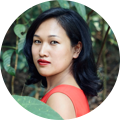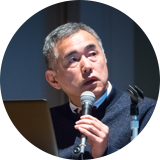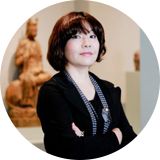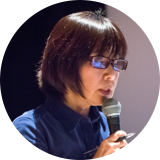SEA PROJECT Symposium
How has Japan Engaged with Contemporary Art in Southeast Asia? Panel Discussion and Q&A (3/4)

Curators Vera Mey (leftmost) and Ong Jo-Lene (the second from the left)

Curators Merv Espina (left) and Grace Samboh (right)
Thank you to all the speakers for their presentations. I have a basic question since the role of public institutions seems like the crux of this panel, especially Prof. Ushiroshoji: considering these previous exhibitions that brought and also current initiatives that are still bringing Southeast Asian artists to Japan, how do you think the Japanese public view their relationship to Southeast Asia? Are these foreign artistic practices seen as part of extensions of Japanese art history? I ask this because I see Japan appear in the various art histories of Southeast Asia. I’m thinking, in particular, about the modernist period in Cambodia; about how the Japanese painter Suzuki taught at the Royal University of Fine Arts [in Phnom Penh] back in the 1950s, and how the Japanese government continues to be involved in development projects in parts of urban Phnom Penh. It goes without saying that these factors affect Cambodian contemporary artists’ engagement and practices in the arts. I am sure there are other kinds of examples across the region too, but I was interested in the ways the Japanese public view Southeast Asian art history in relation to their own.
Another important point I noticed was that Prof. Ushiroshoji spoke about it being different from a Western art history. From my own understanding and research, I feel that Japanese art and art history is perhaps seen as closer to the Southeast Asian paradigm or history than the Western one. Could you elaborate a little on those points?
As I briefly mentioned, I think Southeast Asian art was definitely viewed as “exotic” and rare in the 1980s. As the artworks exhibited in Japan changed, however, Japanese people came to better appreciate the arts of their Southeast Asian counterparts, learning about their anxieties, pain, and joys experienced over the years. It doesn’t necessarily mean that everyone feels that way now, but attitudes have, to some degree, been changing.
Unfortunately, however, I don’t think that Japanese art historians are even interested in the question of how Japan has engaged in this particular field. The existence of Mr. Suzuki in Cambodia, whom you just mentioned, is completely unknown. There are a few Japanese people other than myself who have worked in the field, but overall there is a lack of interest on the part of art historians in Japan; and that, I think, is a very big problem.
Thank you very much. Our next question is from Jo-Lene.
Thank you. This is for Prof. Ushiroshoji again. In the Asian Art Shows―especially the early editions―I noticed that, as you said, artists were picked out from each country, and the points of contact were usually curators who were affiliated with national institutions. I am curious to know if this was a deliberate decision given that, at the time, the formation of a “national identity” was one of the main concerns. Did this influence the decision to have curators specifically from the public sectors as the points of contact? Having constructed some form of national identity, this then gets imposed upon the citizens soon after. What emerged from this, however, are attitudes that challenge this dominant narrative which, I believe, often takes place in art.
So my question is: considering this issue of national identity, to whom do you think we can turn to for our point of contact knowing that, as a The New York Times reporter, once wrote, “But I despaired at the venality of the elites and the corruption that engulfed the lives of so many people I interviewed. I came to see Southeast Asia as a land of great people and bad governments, of remarkable graciousness but distressing levels of impunity.” (*1)
When you oversimplify things, I guess that part of that statement could be true. But when we were working with an Indonesian artist group, there were cases when our counterparts literally couldn’t handle the custom clearance for exporting artworks. Moreover, due to the lack of information, prior to our departure we first had to visit the Embassies of the countries we’d planned on visiting and asked them for advice of where to go, who to visit and so on. Then, once we were there, we would visit the local Japanese Embassies for advice too. Looking back, I think it was inevitable for us to seek help through governmental bodies, but I personally don’t think that that played such a large role on the issue of building a national identity. National identity wasn’t exclusive to government-associated artist; it concerned all artists.
Moreover, as we amassed our research on each country, we began to speak directly and choose specific artists with whom to work. In that way, the types of art displayed in our exhibitions began to change significantly. We began to be able to select artworks that reflected the imminent social problems of that period, but I must say that it took a long time to get there. So, rather than national identity, or governmental involvement for that matter, creating a bias and being criticized for it, I think it was more about suddenly diving into the then-current socio-political concerns that was contemporaneous throughout Southeast Asia.
If I could add to that: I think the New Art from Southeast Asia exhibition (1992) was one of the responses to that kind of 1980s circumstance; I think the flow of organizing an exhibition by seeing works and choosing them ourselves really began from here.

National identity, too, was one of the emphasis Prof. Ushiroshoji made at that time, but I was always very doubtful of that; I wasn’t convinced that Southeast Asian artists’ motivations were solely national identity. When trying to decipher how to discuss an issue, such an argument makes invisible the various other alternatives, making the discussion a linear and singular. The New Art from Southeast Asia exhibition was really an output of that doubt of mine. When asked who the Southeast Asian art historian is in Japan, even after two decades, it is still Prof. Ushiroshoji and his words or studies are considered “legitimate.” I’m not criticizing you personally, Prof. Ushiroshoji. But I do want to say that we need to pay just as much attention to alternatives. Despite our various projects and rise of younger curators, the fact, for example, we hear only Prof. Ushiroshoji’s name in Singapore exemplifies how Japan’s academia is still lagging behind.
To Panel Discussion and Q&A (4/4)





